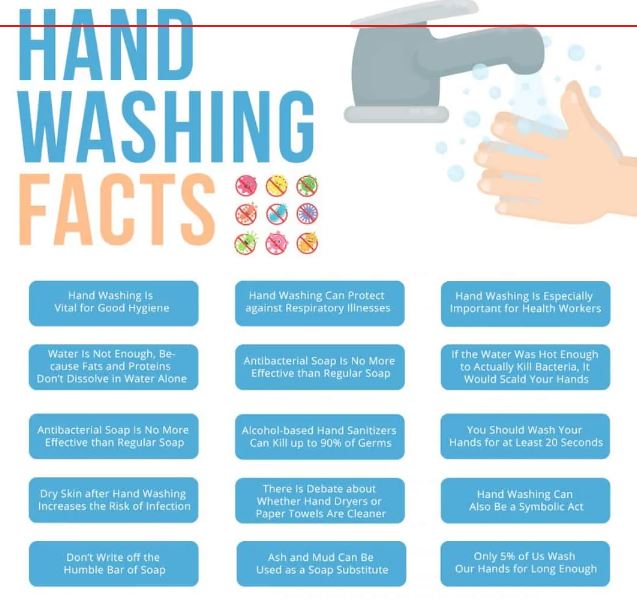
When it comes to hand washing facts, the first point to make is that usually, hand washing is the cleaning of one’s hands for hygienic purposes. Whether using just water, soapy water, hand sanitizer or other means, we clean our hands to try and rid them of dirt and germs. This is very important because countless studies show that hand washing is one of the most effective things we can do to prevent the spreading of disease. Pathogens such as bacteria and viruses are often transferred by touch, but hand washing significantly reduces the chances of this happening. As the Center for Disease Control and Prevention states, “It is well documented that one of the most important measures for preventing the spread of pathogens is effective hand washing”.
Hand Washing Can Protect against Respiratory Illnesses
In particular, respiratory illnesses such as influenza or the common cold are often transferred by touch. This can occur as a result of infected individuals touching their noses, mouths and eyes, or coughing and sneezing into tissues and so on. Then, without washing their hands, they proceed to touch other objects and people. Rather disgustingly, a significant number of diseases are transferred through fecal-oral routes! Again, however, hand washing can help to prevent this. Forms of disease which hand washing can help to prevent include measles, chickenpox, and tuberculosis. Overall, if you’re feeling ill, washing your hands is the biggest favor you can do for the people around you!
Hand Washing Is Especially Important for Health Workers
Since hand washing facts show that the spread of diseases can often be prevented if proper hygiene is observed, it’s unsurprising that this procedure is especially important for anyone in the health industry. Doctors, nurses, dentists and medics, therefore, adhere to rigorous hand washing standards. In addition, it is also very important that anyone working within the food industry is diligent about hand washing. Sometimes, while cooking, we handle things which we know can contain dangerous pathogens − raw chicken, for example, which is often infected with salmonella bacteria. Washing our hands thoroughly after handling such ingredients can help us avoid unpleasant cases of food poisoning.
Water Is Not Enough, Because Fats and Proteins Don’t Dissolve in Water Alone
When it comes to hand washing facts, one of the most important is that water alone is not enough to effectively and hygienically remove germs. This is because if harmful micro-organisms cling to the hands, they are found within organic soil. This soil contains fats and proteins which do not dissolve easily in water, so H20 alone is not enough. Instead, it’s important to use soap and detergents. Common opinion would have it that soap can somehow “kill” germs. But, in fact, hand washing facts indicate that soap actually acts to reduce barriers to solution, and so makes these fats and proteins dissolve more easily in water. For this reason, soap does not work so well alone − flowing water and soap together are a much more effective combination, as the two help to wash the germs away from your skin.
Antibacterial Soap Is No More Effective than Regular Soap
Some commonly mistaken hand washing facts relate to the particular types of soap we should use. In recent years there have been many antibacterial soaps available on the market which claim to particularly target bacteria and provide an extra deep cleaning effect. However, a comprehensive analysis by the School of Public Health at the University of Oregon suggested that plain soaps are just as effective as anti-bacterial ones for reducing instances of illness.
If the Water Was Hot Enough to Actually Kill Bacteria, It Would Scald Your Hands
There are some more popular myths which often pass as hand washing facts. It is commonly believed, for example, that hot water helps to kill bacteria and other germs on your hands. In fact, this is only true at a temperature range that would be painful, and would even injure your skin. At the level of warmth which we can comfortably stand, nothing is done to actively kill bacteria. Don’t despair though − you should still aim to wash with warm water. This is because, while it has no effect on the bacteria itself, warm soapy water is more effective than its cold equivalent at removing the natural oils in your hands. Since these oils tend to cling onto soil and bacteria, washing them away means washing away more germs, too.
Alcohol-based Hand Sanitizers Can Kill up to 90% of Germs
As we have seen from some of our hand washing facts so far, there are several common myths and misconceptions regarding washing our hands with soap and water. There is also a lot of compelling evidence that many of us do not wash our hands for long enough, or under the right conditions, to be effective. But, luckily, in recent years a solution has come onto the market which seems to be not only more effective as a means of eradicating germs, but also faster and easier for daily use.
This solution is alcohol based hand sanitizer, a hygiene agent which doesn’t need water to act. These rubs are getting more and more popular, since they are so easy to rub into the hands and don’t require a towel to dry. They are formed with either isopropyl alcohol or ethanol, along with a thickening agent to decrease the drying effect of the alcohol.
These rubs contain a minimum of 60-95% alcohol, and have been shown to be very effective. Studies suggest that 30 seconds after using one of these hand gels or rubs, 99.97% of bacteria on the hands are killed. Unfortunately, however, they are less effective against certain viruses, including the Norovirus which causes many strands of gastroenteritis.
You Should Wash Your Hands for at Least 20 Seconds
If you’re brushing up on your hand washing facts, one thing you’re probably asking is − how do I properly wash my hands? To begin, you should rinse your hands with warm water, being sure to include the wrists and forearms, and making sure your hands stay lower so that contaminated water can move downwards. Use approximately 5 milliliters of soap, completely covering the hands. Rub your wet, soapy hands together for at least 20 seconds. Rinse thoroughly, from wrist to fingertips. Finally, use a paper towel to turn off the water to avoid picking up microbes from the faucet.









